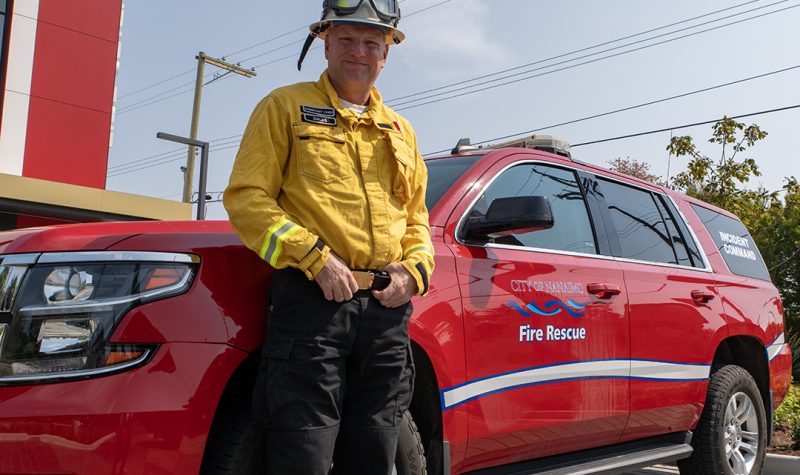David Dales, assistant fire chief for Nanaimo Fire Rescue, was recently deployed to protect homes in Kelowna that were threatened by raging wildfires.
A task force leader heading up a team of local Kelwona firefighters, Dales was in command of what he says is essentially an independent fire department with fire engines, 2200 gallon water tenders, and small bush trucks.
Dales and his team ran “tactical patrols" through the streets of Kelwona looking for signs of fire and responding to 911 calls that residents were calling in from their properties through home security systems and doorbell videos.
“I spoke to people who were in Washington, DC, Washington State, Vancouver, Calgary, calling 911 based on what they saw on their cameras,” he said. “When you respond to their house, their cameras start talking to you and I was actually having dialogue with the homeowner staring into a doorbell camera.”
Many of the firefighters on Dales’ task force were fighting a fire that threatened their own homes and every single member of his team was on evacuation alert.
“They physically weren't able to check on their own house because they were fighting fires at their neighbours' house,” said Dales. “So it's pretty selfless, it's what firefighters sign up for, but to actually witness firefighters driving code three through their own community to fight a fire to save a house, five doors down, driving past their own house, which they haven't inspected.”
Dales has been deploying to wildfire hotspots for decades and says that he sees the intensity of wildfires increasing.
“When I compare it to deployments, and even in Vernon in 2021 where we lost a significant amount of structures, the fire behavior that we witnessed in Kelowna and West Kelowna was even worse than that,” he said. “The data set is small. But personally, I do see a trend where fire behavior is getting worse based on winds, elevated temperatures, decreased relative humidity, and the winds.”
Dales says that while the vast majority of people in Kelowna obeyed evacuation orders there were a few people who stayed behind.
“When people stay behind, it puts firefighters at risk, because if things go from bad to worse, we have to go in and rescue you,” he said. “We like to do rescues based on planning and when we have to drive code three up your long driveway to rescue you, we don't have a lot of time to do planning, so it puts firefighters at risk.”
That said, Dales and his team were able to perform the classic firefighter rescue of saving a cat.
“We did have one evacuated person who couldn't find their cat,” he said. “So we actually went back to the house, found the cat, put it in a cage and brought it out to them. But they didn't follow the alert properly, they didn't plan properly and the weather changed rather quickly. Their neighborhood went from an evacuation alert to an order and they left the cat behind and that caused them a lot of grief, a lot of anxiety.”
Dales says that the best way homeowners can protect their home is to use the Fire Smart BC guide at firesmartbc.ca. He recalls one home in Kelwona that would have been lost if not for the sharp eyes of his team going backyard to backyard at night looking for hotspots.
Dales says he saw the fire being drawn along a wooden fence towards the house like a wick on a candle.
“If they would have fire smarted their fence with non combustible material, maybe a small part of the fence, that fire wouldn't have traveled,” he said.
“Homeowners need to get on the firesmartbc.ca website and do anything that they can do,” Dales said. “Even in Nanaimo, where we do have some south slopes, and we had elevated temperatures above the relative humidity and swirly winds around 20 to 30 km/hr. That is prime weather for a wildfire to have a negative impact on your home, even in Nanaimo so follow fire smart rules.”
Listen to CHLY’s story below:


